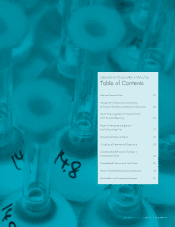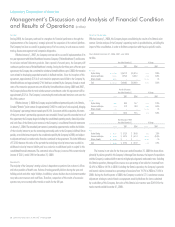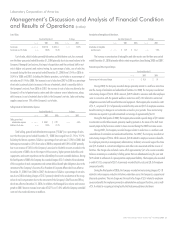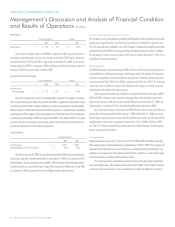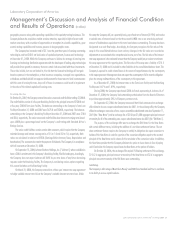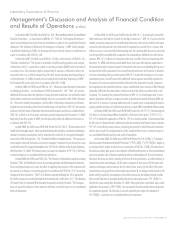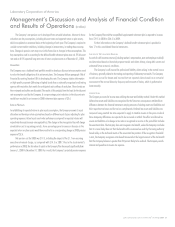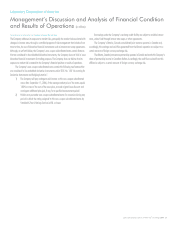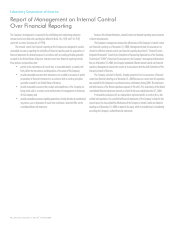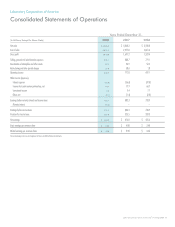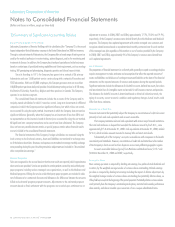LabCorp 2008 Annual Report Download - page 29
Download and view the complete annual report
Please find page 29 of the 2008 LabCorp annual report below. You can navigate through the pages in the report by either clicking on the pages listed below, or by using the keyword search tool below to find specific information within the annual report.Laboratory Corporation of America® Holdings 2008 27
Management’s Discussion and Analysis of Financial Condition
and Results of Operations (in millions)
Laboratory Corporation of America
The Company’s net pension cost is developed from actuarial valuations. Inherent in these
valuations are key assumptions, including discount rates and expected return on plan assets,
which are updated on an annual basis at the beginning of each year. The Company is required to
consider current market conditions, including changes in interest rates, in making these assump-
tions. Changes in pension costs may occur in the future due to changes in these assumptions. The
key assumptions used in accounting for the defined benefit retirement plans were a 6.5% discount
rate and an 8.5% expected long-term rate of return on plan assets as of December 31, 2008.
Discount Rate
The Company uses a laddered bond portfolio model to develop a discount rate assumption used
to value the benefit obligations of its retirement plans. The Company follows paragraph 186 of
Financial Accounting Standard 106 in developing this rate. The Company obtains information
on high-quality corporate (AA rating or higher) bonds from a nationally recognized credit rating
agency with maturities that match the anticipated cash outflows of each plan. These bonds are
then reviewed and outliers are discarded. The results of this analysis form the basis for the discount
rate assumption used by the Company. A one percentage point reduction in the discount rate
would have resulted in an increase in 2008 retirement plan expense of $3.6.
Return on Plan Assets
In establishing its expected return on plan assets assumption, the Company reviews its asset
allocation and develops return assumptions based on different asset classes adjusting for plan
operating expenses. Actual asset over/under performance compared to expected returns will
respectively decrease/increase unrecognized loss. The change in the unrecognized loss will change
amortization cost in upcoming periods. A one percentage point increase or decrease in the
expected return on plan assets would have resulted in a corresponding change in 2008 pension
expense of $2.6.
Net pension cost for 2008 was $19.5, including the impact of the $1.7 non-recurring
executive retirement charge, as compared with $14.5 in 2007. Due to the stock market’s
performance in 2008, the fair value of assets in the Company Plan decreased significantly from
January 1, 2008 to December 31, 2008. As a result, the Company’s projected pension expense
for the Company Plan and the nonqualified supplemental retirement plan is expected to increase
from $19.5 in 2008 to $34.2 in 2009.
Further information on the Company’s defined benefit retirement plan is provided in
Note 17 to the consolidated financial statements.
Accruals for Self-Insurance Reserves
Accruals for self-insurance reserves (including workers’ compensation, auto and employee medical)
are determined based on historical payment trends and claims history, along with current and
estimated future economic conditions.
The Company is self-insured for professional liability claims arising in the normal course
of business, generally related to the testing and reporting of laboratory test results. The Company
records an accrual for known and incurred but not reported claims based on an actuarial
assessment of the accrual driven by frequency and amounts of claims, which is performed at
least annually.
Income Taxes
The Company accounts for income taxes utilizing the asset and liability method. Under this method
deferred tax assets and liabilities are recognized for the future tax consequences attributable to
differences between the financial statement carrying amounts of existing assets and liabilities and
their respective tax bases and for tax loss carryforwards. Deferred tax assets and liabilities are
measured using enacted tax rates expected to apply to taxable income in the years in which
those temporary differences are expected to be recovered or settled. The effect on deferred tax
assets and liabilities of a change in tax rates is recognized in income in the period that includes
the enactment date. The Company does not recognize a tax benefit, unless the Company concludes
that it is more likely than not that the benefit will be sustained on audit by the taxing authority
based solely on the technical merits of the associated tax position. If the recognition threshold
is met, the Company recognizes a tax benefit measured at the largest amount of the tax benefit
that the Company believes is greater than 50 percent likely to be realized. The Company records
interest and penalties in income tax expense.


